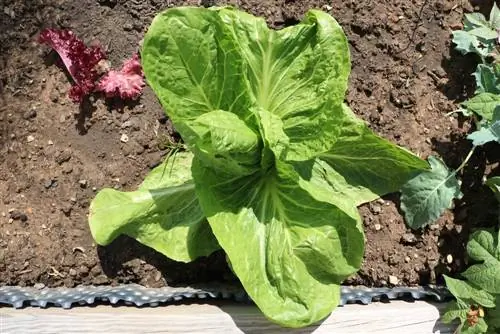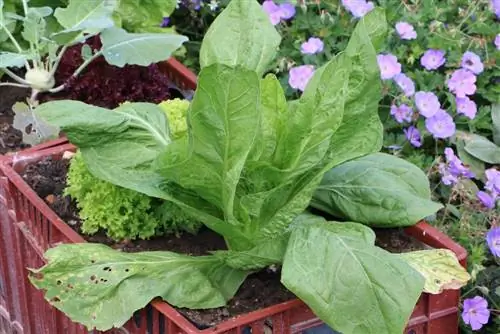- Author admin [email protected].
- Public 2023-12-17 03:39.
- Last modified 2025-06-01 06:48.
With its tart, aromatic taste, sugarloaf salad brings vitamin-rich variety to the winter menu. The high appreciation of the local chicory species is based not least on its uncomplicated cultivation as a summer crop as well as its reliable frost tolerance down to -4 degrees Celsius. When the first harvest has cleared the vegetable garden in summer, prudent home gardeners plant the tasty autumn chicory with its shapely heads. These instructions explain step by step how to grow meatwort.
Planting time is in summer
The window for planting or sowing opens at the end of June. There are two arguments in favor of this appointment. Experience has shown that sugarloaf plants tend to bolt after previous cultivation, which significantly affects quality. In addition, at this time the beds with spring crops have been harvested, leaving behind the ideal soil for your autumn chicory.
Tip:
Meatwort is the ideal secondary culture for legumes and spinach. When mixed, sugarloaf lettuce harmonizes wonderfully with carrots, tomatoes, fennel and lettuce. However, autumn chicory should not share the bed with parsley or celery.
Location
Sugarloaf lettuce thrives in all sunny to partially shaded locations with normal garden soil. Special location preferences therefore do not need to be taken into account. Fresh, moist, well-drained soil with vital soil life is ideal. As a rule of thumb: Where legumes thrive, meatwort also does its best.
Prepare the bed professionally
A mild, dry day between the end of June and the beginning of July offers the best conditions for preparing the bed for growing meatwort. The following work creates the ideal conditions for seedlings and seeds alike. How to do it right:
- Rake the bed thoroughly with the cultivator
- Meticulously remove weeds, stones, clods of earth and crop residue from the previous crop
- Smooth the fine crumbly soil with the rake
It is an advantage if you then superficially incorporate ripe, sifted compost. Alternatively, spray the bed with diluted nettle liquid to ensure vigorous growth of your sugarloaf plants right from the start.
Planting seedlings

Just in time for the start of the planting season, garden centers and specialist retailers offer ready-made meatwort seedlings. The shorter the time between purchase and planting, the better for the young plants. This is how you proceed professionally:
- Put the still potted sugarloaf seedlings in water
- Meanwhile, stretch a planting cord in the prepared bed to ensure that the seed rows are aligned straight
- Place the potted seedlings along the planting cord at a distance of 30 cm
- Place additional young plants at a row spacing of 30 cm, offset by half the distance
Use a hand shovel to dig a small planting hole for each sugar loaf. Plant a root ball deep enough so that it ends up just below the soil surface. Press the soil all around with your hands to ensure a good seal without air holes. Finally, water your pupils with the watering can.
Direct sowing - easy and cost-effective
In order to grow a larger number of sugarloaf lettuce or to save the costs of purchasing early seedlings, direct sowing is becoming the focus. There are no differences between the two cultivation options in terms of planting time and soil preparation. How to sow the seeds correctly:
- Draw a shallow seed groove along a planting line
- Spread the seeds there and cover them thinly with soil or sieve over them with sand
- Press the substrate lightly with your hands or a board
- Plan further rows of seeds at a row spacing of 30 cm
- Water the bed with a fine spray
- Sowing with a close-meshed net protects against birds and pests
Narrow sowing offers the advantage that you can harvest seedlings as cut lettuce from August with a growth height of 15 cm. Leave one meatwort plant at a distance of 30 cm to allow it to mature until October/November for use as a winter salad.
Proper care until harvest - tips & tricks
Regular weeding is the central care measure in the sugarloaf bed in the first few weeks. If the soil dries out, water the sugarloaf lettuce without wetting the leaves. If you carried out basic fertilization as part of the soil preparation, no further nutrient supply is necessary. Otherwise, incorporate mature compost every 4 weeks. The administration of highly diluted nettle manure promotes the growth of the leaves in a natural way. By switching to comfrey manure from September onwards, you can strengthen your frost tolerance with the potassium it contains.
The longer sugarloaf lettuce can stay in the bed, the milder it will taste. To delay the harvest for as long as possible, the following trick has proven itself:
- Put a clay pot over each sugarloaf salad
- Alternatively, protect the heads with fleece or a thick layer of straw
To prevent mold from forming under the hood, the leaves on meatwort should be completely dry.
You can choose to harvest mature autumn chicory with or without roots. For long-term storage, remove the outer leaves and wrap each head in towels or newspaper. In a cool, dark cellar or cold frame, the harvest stays fresh and crisp for many weeks.

Tip:
You can significantly reduce the bitter aftertaste of sugarloaf salad with a simple trick. For this purpose, place the leaves in lukewarm water for a while shortly before preparation.
Great moments in variety
For many years, specialist retailers only offered a single variety for growing sugarloaf lettuce. Following the desire for more robust hybrids with a milder taste, the following modern varieties are available today:
Jupiter F1
The innovative breeding produces half-high heads and is suitable for early sowing from March/April. If the Jupiter sugar loaf lettuce experiences brief frost of up to -7 degrees Celsius, it noticeably loses its bitter taste.
Uranus F1
The heads of Uranus fleshwort also remain halfway up the classic variety. A special feature that sets this hybrid apart from its counterparts is its significantly firmer lettuce heads, which can be stored until March. Even after sowing before the ideal summer date, Uranus does not tend to sprout.
Pluto F1
Degraded from a planet to a dwarf planet in the cosmos, Pluto, as a sugarloaf variety, cannot be prevented from boasting large, solid heads. Furthermore, the new variety scores with a wonderful, nutty aroma and reliable frost tolerance down to -8 degrees Celsius.
Conclusion
When the warm summer weather picks up, the starting signal for planting sugarloaf lettuce is given. The local variety of chicory brings fresh vitamin enjoyment to the table well into winter, without having to endure the stress of importing it from distant countries. From the end of June to the beginning of July, seedlings are placed in the bed with a row and planting distance of 30 cm. The direct sowing of seeds is similar and is protected from uninvited guests with a net. The uncomplicated care program consists of weeding, watering in dry conditions and fertilizing with compost or nettle manure. Although the regular harvest season begins at the end of October, the ripe heads of lettuce should remain in the bed for as long as possible so that they reach the table with an extra mild taste. Only at temperatures below -4 degrees Celsius does the robust meatwort reach the limits of its frost tolerance. Wrapped in cloths or newspaper, you can store the extremely he althy fresh food in the cool cellar for weeks.






